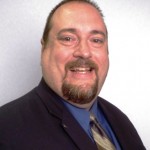Let me start by saying that growing up, I never considered myself to be a science nerd. Science was never really something around which I foresaw my adult life revolving. As a student, it stood for spilled chemicals in laboratories, confounding physics equations and the dissection of poor, defenseless organisms. However, a turning point that perhaps, looking back nearly 20 years later, drove me toward the scientific side of public relations was the day my best friend and I had to make up a high school biology class after hours.
The assignment wound up being a horrendous but hilarious experience—we had to dissect a fetal pig, separating and marking each organ. While we vacillated between bouts of laughing and gagging, the lab door opened and in walked our admissions director—and actor Martin Short! He was filming in New York City and looking at our school for his daughter at the time. He took one look at our messy “operating table,” our filthy lab coats and our horrified faces and said, smirking, “You two aren’t enjoying this too much, I see,” to which I responded, “Imagine how this pig feels!” I was already lobbying for the rights of the patient at a young age.
But I digress. Suffice to say, the 15-year-old me did not prophecy that the 30-(ahem)-something-year-old version would spend her days researching countless medical conditions, reading scientific abstracts, meeting with advocacy organizations, developing social media programs and media training healthcare professionals and patients. But that’s what I do nearly every day after catching up on the morning’s news about this ever-evolving industry. And, admittedly, I still love it. So long as no one hands me a scalpel and a pig.
How Do You Define Healthcare PR?
I’ve come to find throughout my career that healthcare PR is somewhat undefinable, which is what makes it undeniably exciting. Healthcare is a niche that is constantly changing, given legal and regulatory challenges in spaces like social media, coupled with the powerful changes that healthcare reform has – and will continue to have – for patients, healthcare professionals, advocacy and payors. For me, PR wasn’t a hard career choice, as it’s the perfect confluence of strategizing, socializing, researching and writing. In fact, I’m pretty sure it found me. The healthcare focus, though, was a happy accident, one that started as just a job but wound up becoming a fulfilling career.
Like nothing else, healthcare PR provides the satisfaction of knowing you are helping people at the end of the day: helping patients better understand what a diagnosis may mean; helping patients and loved ones manage through life’s health challenges with tools and resources to be better informed and empowered; helping discover ways to jumpstart and facilitate meaningful conversations between patients and healthcare professionals that may not have been happening. Some of the most moving moments in my career have been when I’ve helped coordinate patient speaking opportunities at client headquarters, bringing together employees across multiple disciplines to hear first-hand how their work positively impacts people’s lives. It’s a gratifying feeling to know that an idea you had, a meeting to which you contributed or a program you built went to helping people get better and feel better at the end of the day.
Your Career Roadmap
As a new professional, you may occasionally (or often) feel like a sponge, looking to soak up as much information as you can. Healthcare PR offers an opportunity to never lose that feeling: continuous environmental, economic and societal changes make healthcare PR a rewarding challenge, and I would encourage you to learn more about it. At GolinHarris, we often say healthcare PR is the art and science of blending clinical understanding and knowledge with best practices of consumer marketing. But regardless of what area of PR you may choose to pursue, seek to be challenged every day. Read industry publications. Get more involved with PRSA and network. Find a mentor. Ask questions. Don’t balk at “no.” Learn and adjust. And above all, have a good time doing your job.
 Debbie Harvey, MS, APR, is a senior vice president in healthcare at GolinHarris. She holds a master’s degree from Northwestern University in integrated marketing communications and is president-elect of the Public Relations Society of America (PRSA) Chicago Chapter. A Big Apple native, she has learned to love the Windy City nearly as much. Follow her on Twitter, connect with her on Facebook, or email her at dharvey@golinharris.com.
Debbie Harvey, MS, APR, is a senior vice president in healthcare at GolinHarris. She holds a master’s degree from Northwestern University in integrated marketing communications and is president-elect of the Public Relations Society of America (PRSA) Chicago Chapter. A Big Apple native, she has learned to love the Windy City nearly as much. Follow her on Twitter, connect with her on Facebook, or email her at dharvey@golinharris.com.

